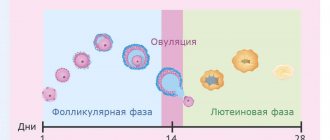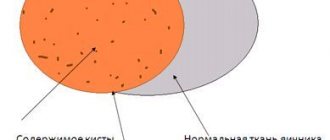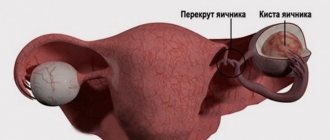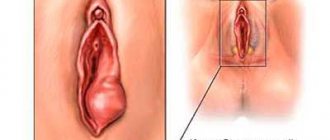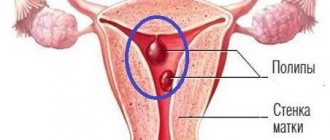An ovarian cyst is a benign neoplasm localized in the tissues of the organ; it is a cavity filled with fluid. When treating this neoplasm, it is possible to use medications or surgical removal of the ovarian cyst; the price of this service varies depending on the type of medical institution.
Many women who have been diagnosed with this disease ask many questions related to how long the operation to remove an ovarian cyst lasts and what the consequences may be after removing the tumor. Specialists at the Oncology Clinic of the Yusupov Hospital honestly and clearly answer patients’ questions, so after consultation you know how to remove an ovarian cyst in women.
Removal of an ovarian cyst: types of operations
Ovarian cysts are diagnosed in most cases in women of reproductive age, but the development of neoplasms can occur during the postmenopausal period. If a woman is indicated for removal of an ovarian cyst, what operation will be performed is determined by the surgeon based on the diagnostic results. At the Yusupov Hospital, the decision to prescribe surgical removal of a tumor is made by a council of doctors committed to interdisciplinary cooperation.
Removal of an ovarian cyst, the price of which in Moscow in private clinics may be higher, is performed using several methods:
- Removing an ovarian cyst with a laser is the fastest and most accurate compared to other methods. With this method of removal, the likelihood of bleeding is minimal, since the laser beam not only cuts the tissue, but also cauterizes the damaged blood vessels;
- Ovarian laparoscopy is an operation in which three small incisions are made in the lower abdomen through which the surgeon inserts instruments and a miniature camera. Laparoscopy in modern medicine is a minimally invasive and painless procedure that is used by surgeons at the Yusupov Hospital, which is a place where surgery to remove an ovarian cyst can be done efficiently and with minimal damage. When removing an ovarian cyst, healthy tissue is not injured.
- Laparotomy of an ovarian cyst is based on making incisions on the woman’s abdomen through which a benign tumor or ovary is removed. Abdominal surgery to remove an ovarian cyst is prescribed in exceptional cases: in case of large neoplasms, purulent processes, torsion of the cyst, or malignant tumor.
At the Oncology Clinic of the Yusupov Hospital, ovarian cysts are removed with a laser; in addition, specialists are proficient in laparoscopy and laparotomy techniques. Surgical removal of an ovarian cyst at the Yusupov Hospital is preceded by a comprehensive diagnosis and consultation with experienced specialists.
Diagnosis of symptoms of tooth root cyst
The appearance of a cyst implies the formation of a cavity, which gradually grows while simultaneously filling with pus. This condition can last for a long time, and the patient does not experience pain. A sign suggesting the presence of a cyst is slight pain that occurs when pressing on the gum. Such a symptom only in rare cases becomes a reason to visit a dentist. Basically, it occurs in later stages, when the pain intensifies and becomes nagging, continuous, cannot be relieved with analgesics, and inflammation begins to additionally manifest itself in the form of swelling and swelling of the gums in combination with a persistent unpleasant odor in the oral cavity. Finally, a situation cannot be ruled out in which a fistula occurs - that is, a channel through which the contents of the cavity independently come out.
An effective way to detect a cyst in a timely manner is to conduct an X-ray examination followed by its opening and removal.
It should be noted that at the very beginning the disease poses minimal danger to surrounding tissues, since the cavity itself is reliably isolated by thick walls. However, as pus accumulates, the pressure on the walls increases, creating the possibility of a breakthrough, which can lead to blood poisoning and, in the long term, damage to the structure of the jaw bones. At the same time, the dynamics of cyst development are unpredictable and strictly individual. However, in the presence of other inflammatory processes or infections, in a weakened body the transition to the acute stage can occur quickly.
Particular attention should be paid to early diagnosis of the disease in pregnant women. This is due to the complexity of treatment: during pregnancy, only stabilization of the cyst is possible. If the inflammatory process worsens, the choice of treatment methods is strictly limited. That is why, at the planning stage of pregnancy, it is necessary to undergo a full examination by a dentist.
Surgery to remove an ovarian cyst: indications
The tactics of surgical treatment of ovarian cysts are determined by several factors, including the stage of the disease, the type of tumor, the likelihood of an oncological process and concomitant diseases. The operation to remove an ovarian cyst, the price of which is determined by the conditions of the patient’s stay in the clinic, at the Yusupov Hospital is aimed at preserving the function of the ovary and the reproductive health of the patient.
The main indications for the use of various methods of surgical treatment of ovarian cysts are:
- rapid increase in cyst size;
- high probability of degeneration of a benign tumor into a malignant neoplasm;
- severe abdominal pain;
- signs of compression of nearby organs.
Emergency removal of an ovarian cyst, the price of which is determined according to the current price list of the Yusupov Hospital, is carried out in the event of tumor rupture, twisting of its stem, hemorrhage and other complications. The Yusupov Hospital accepts patients in serious condition on weekends and holidays, 24 hours a day.
Types of ovarian cysts depending on their formation and method of occurrence
The types of ovarian cysts can be as follows:
Follicular
It is born from bubbles, has smooth walls, a uniform base with a liquid-filled cavity. The diameter is 8 cm maximum. It is formed due to endocrine pathologies, so it is often discovered during puberty or menopause. Small cysts (up to 4 cm) can form without symptoms and go away on their own after 3 menstrual phases. If the follicular ovarian cyst is more than 8 cm, then the woman will feel the following signs: cycle irregularity, long painful periods with excessive discharge, blood clots between periods and after sex, abdominal pain that worsens in the second phase of menstruation, after intense and sudden activities, sex, a feeling of squeezing, bursting in the groin area.
Yellow
Appears in the second phase of menstruation from a yellow body, which does not go away during a certain period. As soon as the vesicle opens and a new egg is released, a yellow body is born in this area. If there is no conception in this interval, then the yellow body is eliminated on its own due to the fact that there is no blood flow. But if blood circulation is impaired, the corpus luteum is capable of reproducing cysts no more than 8 cm in diameter; their cavity is filled with yellow-red liquid. Often this tumor is formed due to a malfunction of the hormonal system and blood flow in the appendages. The pathology develops due to the inflammatory process in the appendages, hunger strike, unbalanced nutrition, prolonged stress, induced abortion, preparation for artificial insemination, and taking hormonal contraceptives. Symptoms are less pronounced: pain and a feeling of bricks in the abdomen in the area of the neoplasm, delayed menstruation, prolonged menstruation. Such cysts appear within 3 months and then go away on their own.
Paraovarian cyst
It is born from the epioophoron between the cavities of the uterine ligament, the ovary and the tube. Located on the side or above the uterus. This is a tumor with one compartment of a refractory mass with a depression, in which there is a transparent essence with protein and a minimal amount of mucin. Gradually, the contents accumulate, creating a thin bag with smooth walls. Such a cyst is oval or round, small or large, sometimes the size of a baby’s head. Formed during the 3rd-4th decade of a woman’s life. Neoplasm is observed in 15% of cases of all detected formations. Develops without symptoms. But some women feel a tightening in their back, pain in the lower abdomen, menstruation fails, and it is impossible to conceive a child. Such symptoms occur when the diameter of the formation is more than 5 cm. With further formation, the pain becomes bursting and aching, radiating to the abdominal area. Women often attribute such pain to physical activity.
Mucinous
This is a benign tumor with a hilly base and an impressive depression in which the mucus is located. The distinctive characteristics of the neoplasm are large volumes and speed of development. As a rule, such formations are found in females after 45 years of age, since the main cause is considered to be hormonal changes at the time of menopause. Symptoms: nagging pain in the vaginal area, bloating due to the growth of the cyst in size, hard stool and rapid filling of the intestines.
Dermoid
This formation also does not pose any particular danger. It contains various biological materials of the body. The diameter of the cyst can reach more than 15 cm. The appearance of an ovarian cyst on ultrasound may result in hormonal changes during the menstrual pause or puberty. Symptoms occur when the cyst increases in size: heaviness, bloating, excessive urination, gastrointestinal disorders.
Endometrioid
This type belongs to genital endometriosis, since the lateral side of the cyst is created from the endometrium. The endometrium is a material that, under normal conditions, lines exclusively the uterus, but in the case of endometriosis, you can notice the movement of endometrial cells into other organs. However, many experts have a different opinion about this phenomenon: the outflow of blood through the uterine cavity, which may be associated with physical activity or sex during menstruation. Endometrial cells that enter the abdominal area attach to the tissues. Such cells are hormone-dependent, so their reproduction occurs under certain conditions. As a result, an endometriotic island appears, in the inner part of which blood collects, which never left the body. A neoplasm appears with a diameter of 1 to 10 cm. The appearance of such a formation can also be caused by surgical interventions and abdominal injuries, decreased immunity, stressful situations, etc. In many cases, an endometriotic cyst is not characterized by specific symptoms, but at the time of its development, unpleasant sensations may appear in the lower abdomen and back area. Menstruation irregularities are observed. In the worst case, a neoplasm can result in infertility for a woman. Impressive in size formations cause urinary disorders, the formation of hard stools and flatulence. If the cyst remains in the body for a long time, destruction, purulent discharge and adhesions may occur.
Polycystic ovary syndrome
With this pathology, a huge number of small cavities appear in the ovaries. The main reason for the appearance of this pathology is the body's insulin resistance (when there is a failure in the recognition of insulin and the absorption of sugar). As a result, insulin increases, and its excess negatively affects the ovaries. Because of this, the formation of androgens (male hormones) increases, which prevent bubbles from forming normally, resulting in many unexploded cavities. Reasons for the appearance of polycystic disease: premature or late sexual development, late or premature menopause, irregular periods, abortion, miscarriages, inability to have children, inflammation of the appendages, hormonal imbalance, infrequent sex, obesity or excessive thinness, diabetes mellitus, hereditary factor, long stress, high physical activity.
Polycystic disease can be primary or secondary.
- Initial. Formed at the time of sexual formation. Imbalance of hormones in teenage girls provokes the late arrival of menstruation, or they may not occur at all. The recovery period of menstruation occurs with disruptions; oligomenorrhea (scanty discharge of blood) or amenorrhea (no discharge at all) occurs, which indicates that the egg remains in the ovaries.
- Secondary. Older ladies with extra pounds and high insulin levels face this disease. Polycystic disease is often accompanied by the inability to have children; moreover, it causes the following changes: hair appears on the body, the skeleton changes to the male side, subcutaneous abdominal tissue is formed, and the voice changes. This condition requires a systematic examination by a doctor, since if this is not done, uterine cancer may develop.
How to remove an ovarian cyst in women
Many patients who have been diagnosed with an ovarian cyst ask the specialist how the operation is going. At the preparatory stage, a woman undergoes a series of studies and tests. In addition, specialists at the oncology clinic recommend that patients before surgery adhere to a special diet that excludes foods that cause gas formation.
Removal of the tumor in various ways occurs in stages. Thus, laser removal of an ovarian cyst is based on cutting the skin with a laser beam, which also excises the tumor. During laparoscopy, a small hole is created on the anterior abdominal wall through which a camera is inserted, and instruments are inserted into the abdominal cavity through two other punctures. After this, the progress of the operation is displayed on a special screen. During laparoscopy, at the initial stage, the cyst capsule is punctured and its contents are extracted, then the membrane is removed. To prevent an infectious process, the abdominal cavity is washed with an antiseptic solution. At the final stage, the surgeon sews up the punctures.
During laparotomy, a cyst on the ovaries in women is removed; the operation can also be aimed at excision of the ovary. During this operation, an incision is made in the abdomen through which the cyst or ovary is removed. Specialists at the Yusupov Hospital perform laparotomy in cases where a neoplasm threatens a woman’s life.
What is a dental cyst and how to remove it?
Radical dental cyst is a complex chronic disease. It has its own shell and is filled with purulent contents. The disease progresses on the roots and under the gum. A cyst appears when early infectious inflammation, which is based on pathogenic microflora, is not treated.
Removal of a dental cyst is performed surgically . The tumor can grow, affecting the gums and cheeks from the inside of the mouth. In some cases, sepsis may develop.
All this makes it difficult for the patient to function normally. To cure the disease, conservative methods are used:
- at the beginning of the procedure, the doctor informs the patient about the possible consequences (it is worth making this the first point);
- the doctor performs an opening of the dental cavity;
- cleansing the cavity from affected tissues;
- treatment with solutions of antibiotics and antiseptics;
- Then, within half an hour, the tooth cyst is removed without removing the tooth .
The patient will have a chance for recovery and further normal life. The main feature of this disease is its asymptomatic course. The patient may remain unaware for a long time. The consequences of this disease can lead to another complex process - sinusitis (if the cyst is located near the sinuses). It is imperative to monitor the cleanliness of the oral cavity and the condition of the gums, and also come to the doctor for sanitation on time.
Removal of an ovarian cyst: consequences
When an ovarian cyst is removed, patients at the Yusupov Hospital are in the hospital for about 5 days; during this period, the women recover in a rehabilitation clinic and are under the supervision of experienced specialists. Surgery to remove an ovarian cyst, the price in Moscow may be overpriced in some medical institutions, is associated with the risk of complications.
Possible consequences of surgery may include wound infection, blood clots and bleeding. During the operation, complications may arise due to individual intolerance to drugs and their components, however, specialists at the Yusupov Hospital identify possible problems at the preparatory stage. When visiting a specialist at the oncology clinic at the Yusupov Hospital, a woman is provided with information about how much ovarian cyst surgery costs and how it will be performed.
Characteristic
Depending on the location of the pathology, a paraovial cyst can be:
- right-sided;
- left-handed.
Tumors are classified according to size:
- Small - up to 2.5 cm without stem. They occur without characteristic signs and do not cause any complications.
- Large - more than 5 cm. They can form a pedicle, which consists of an ovary or fallopian tube. The presence of a stalk can lead to serious complications, as it can twist, causing inflammation and suppuration of the contents of the capsule.
Histology of ovarian cyst after surgery
Histological examination of the tumor is carried out after its excision to determine the nature of the tumor. Specialists at the Oncology Clinic of the Yusupov Hospital pay special attention to information work with patients; during the consultation, they explain how the operation to remove an ovarian cyst is performed, and what studies will be required in the future.
During histological examination, specialists study the structure of tissues. Histology makes it possible to differentiate an ovarian cyst into a benign, borderline form and a malignant tumor, which is necessary for choosing further treatment. After the ovarian cyst is excised, the operation is performed, the price is announced by the clinic and the bill is paid by the patient, the interaction and treatment of the woman does not stop. Specialists at the oncology clinic accompany patients until complete recovery and subsequently conduct comprehensive examinations to exclude relapses.
Get a consultation
We will answer all your questions before visiting the clinic!
+7
Online registration
Removal of a dental cyst by resection
Removal of a dental cyst by resection of the root apex is a tooth-saving operation, i.e., making it possible not to part with the tooth. It is carried out by excision of the root and removal of the affected fragments. Then, to avoid the spread of infection to adjacent areas of hard and soft tissue, the canal is sealed. As a result, this is a good way to cure a dental cyst at the initial stage without removing the entire unit. If a fragment of the tooth remains, it will be replaced with prosthetics in the future. Tooth-preserving methods are valued by specialists because they help preserve the integrity of the dentition. Therefore, resection of the root apex is also used in other cases:
- Inflammation of the tooth under the crown. The obvious solution is to remove the prosthesis, remove the abscess, and install a new design. However, these manipulations are more costly and time-consuming than root resection.
- Root canal abscess, often irregularly shaped, due to unscrupulous filling or the use of low-quality materials.
- With osteomyelitis. There is a need to cut out the affected areas of bone tissue at the border with the roots. This helps prevent deep infection.
- When foreign objects are detected in the channels - boron particles, files. This happens when using low-quality equipment. Our clinic uses the latest instruments based on titanium alloy.
However, such an effective operation has contraindications. Removal of a dental cyst by resection is not carried out if: diseased and healthy roots are located critically close; in the presence of extensive chips of the crown; high tooth mobility; in the stage of acute periodontitis. Not recommended for people with diabetes, mental and nervous disorders, chronic heart and vascular diseases, pathologies of the lungs and thyroid gland.
Cost of surgery to remove an ovarian cyst
The staff of the Yusupov Hospital cares about their patients and offers high-quality medical services that meet international standards. Patients at a medical facility will learn how much surgery to remove a cyst costs before treatment begins. The cost of therapy is calculated in accordance with the current price list.
The oncology clinic has created comfortable conditions for patients to stay. The wards are equipped with the necessary accessories for a comfortable stay and proper treatment. Thus, a woman who has undergone resection of an ovarian cyst is restored under the supervision of experienced rehabilitation doctors, oncologists, and surgeons.
Choosing a clinic: where to remove an ovarian cyst in Moscow
Women who are indicated for removal of an ovarian cyst prefer to go to private medical institutions that offer comprehensive diagnostic and treatment programs, as well as comfortable conditions for patients. The operation to remove a cyst on the ovary is performed in operating rooms equipped with European equipment. At the Yusupov Hospital, highly qualified oncologists and surgeons perform removal of ovarian cysts in Moscow using minimally invasive technologies.
Cooperation with leading clinics in Moscow allows us to carry out complex surgical treatment when tumors are detected in patients. High-tech equipment and many years of experience of specialists make it possible to remove a huge ovarian cyst and subsequent rehabilitation of patients.
Patients of the Yusupov Hospital can receive a full cycle of medical services: diagnostics, prevention, outpatient and inpatient treatment and rehabilitation after surgery. During the consultation, the specialist tells the woman in detail how an ovarian cyst is removed, how long rehabilitation lasts, and the possible consequences of surgery.
